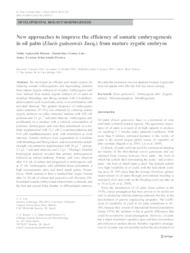New approaches to improve the efficiency of somatic embryogenesis in oil palm (Elaeis guineensis Jacq.) from mature zygotic embryos.
New approaches to improve the efficiency of somatic embryogenesis in oil palm (Elaeis guineensis Jacq.) from mature zygotic embryos.
Author(s): BALZON, T. A.; LUIS, Z. G.; PEREIRA, J. E. S.
Summary: We developed an efficient and simple system for inducing somatic embryogenesis and regenerating plantlets from mature zygotic embryos of oil palm. Embryogenic calli were induced from mature zygotic embryos of oil palm on modified Murashige and Skoog medium with 2,4-dichlorophenoxyacetic acid or picloram, alone or in combination with activated charcoal. The greatest frequency of embryogenic callus induction (97.5%) was obtained by culturing mature zygotic embryos on callus induction medium with 450 μM picloram and 2.5 gL−1 activated charcoal. Embryogenic calli proliferated on a medium with a reduced concentration of picloram. Embryogenic calli were then subcultured on a medium supplemented with 12.3 μM 2-isopentenyladenine and 0.54 μM naphthaleneacetic acid, with subcultures at 4-wk intervals. Somatic embryos were regenerated on a medium with Murashige and Skoog macro- and micronutrients at halfstrength concentrations supplemented with 20 gL−1 sucrose, 2.5 gL−1 activated charcoal, and 2.5 gL−1 Phytagel. Detailed histological analysis revealed that somatic embryogenesis followed an indirect pathway. Primary calli were observed after 4?6 wk of culture and progressed to embryogenic calli at 12 wk. Embryogenic cells exhibited dense protoplasm, a high nucleoplasmic ratio, and small starch grains. Proembryos, which seemed to have a multicellular origin, formed after 16?20 wk of culture and successive cell divisions. Differentiated somatic embryos had a haustorium, a plumule, and the first and second foliar sheaths. In differentiated embryos, the radicular protrusion was not apparent because it generally does not appear until after the first true leaves emerge.
Publication year: 2013
Types of publication: Journal article
Keywords: Zygotic embryo, morphogenesis
Observation
Some of Embrapa's publications are published as ePub files. To read them, use or download one of the following free software options to your computer or mobile device. Android: Google Play Books; IOS: iBooks; Windows and Linux: Calibre.
Access other publications
Access the Agricultural Research Database (BDPA) to consult Embrapa's full library collection and records.
Visit Embrapa Bookstore to purchase books and other publications sold by Embrapa.

